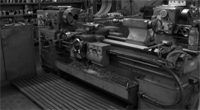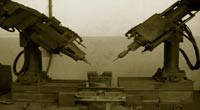About usHistoryThese DaysWhat next
  | Abbiategrasso 1945 - Via Caprera A Miller A Pantograph A Lathe A Miller A Pantograph A Lathe The Company has an antique heart in glass. Strada brothers' long experience in glass factories took Giuseppe, Domenico and Luciano to an important decision. Giuseppe and Domenico gained their experience in glass at IVISC (Industria Vetraria Italiana San Cristoforo), a glass factory of the Saint-Gobain group based in the outskirts of Milan. While Luciano engaged to Fiaschificio Lombardo based in Abbiategrasso. At the end of World War II, Giuseppe went back to his mechanical workshop in which he used to produce parts for agricultural machinery with a new tip: he started the repair of spare parts for semi automatic machines . In 1945 Giuseppe, Domenico and Luciano decide to introduce the maintenance as well as the production of moulds for semi-automatic machines: with only a miller, a pantograph and a lathe IVISC decision to trust the small Abbiategrasso based company in Via Caprera. It is this winning decision in 1948, the workshop moves to Via Cagnola as the growth in the business is stunning. These were the “revolutionary” years: the company definitely quit the production of agricultural machinery to deal exclusively with moulding for Lynch and IS machines. AVIR Asti and Zignago Vetro reward this choice introducing Strada as a permanent supplier. During these years many new features, such as technology innovations appear in glass; the great experience is going to be made. The general improvements in production technologies are closely followed in moulding articles for the largest Italian glass factories from Via Cagnola H.Q. In the ' 70 a new move in Abbiategrasso is recorded. Via Ada Negri is going to be the ultimate H.Q. that will increase greatly production for moulds for IS machines, and at the same time will produce the first goblets using spark erosion and the firsts R7 compatible moulds. The production is set up at a high level and the relationships with the main Italian glass factories are flourishing. Giuseppe decides to leave the management of the company but will continue to stay in it as a representative role. Domenico now manages the production, Luciano develops and improves the relationships with existing customers. In the early ' 80 it is the time of the CNC revolution. The first CNC machines are successfully introduced in the company: production speeds are increased as well as the ratio cavities/month. Giuseppe (son of Luciano) enters the family firm to train into the Commercial department from his father. In the early ' 90’s individual PCs, CadCAM are introduced. Thanks to the hard work of the “new entry” Luca (Domenico’s son), a new revolution in the field of Production layout is going to be scored in 1995. During the same year the company starts trying new opportunities abroad. Paola Leoni joins the company to develop the first contacts abroad. From this moment onwards, the growth in export trade is relentless. |

